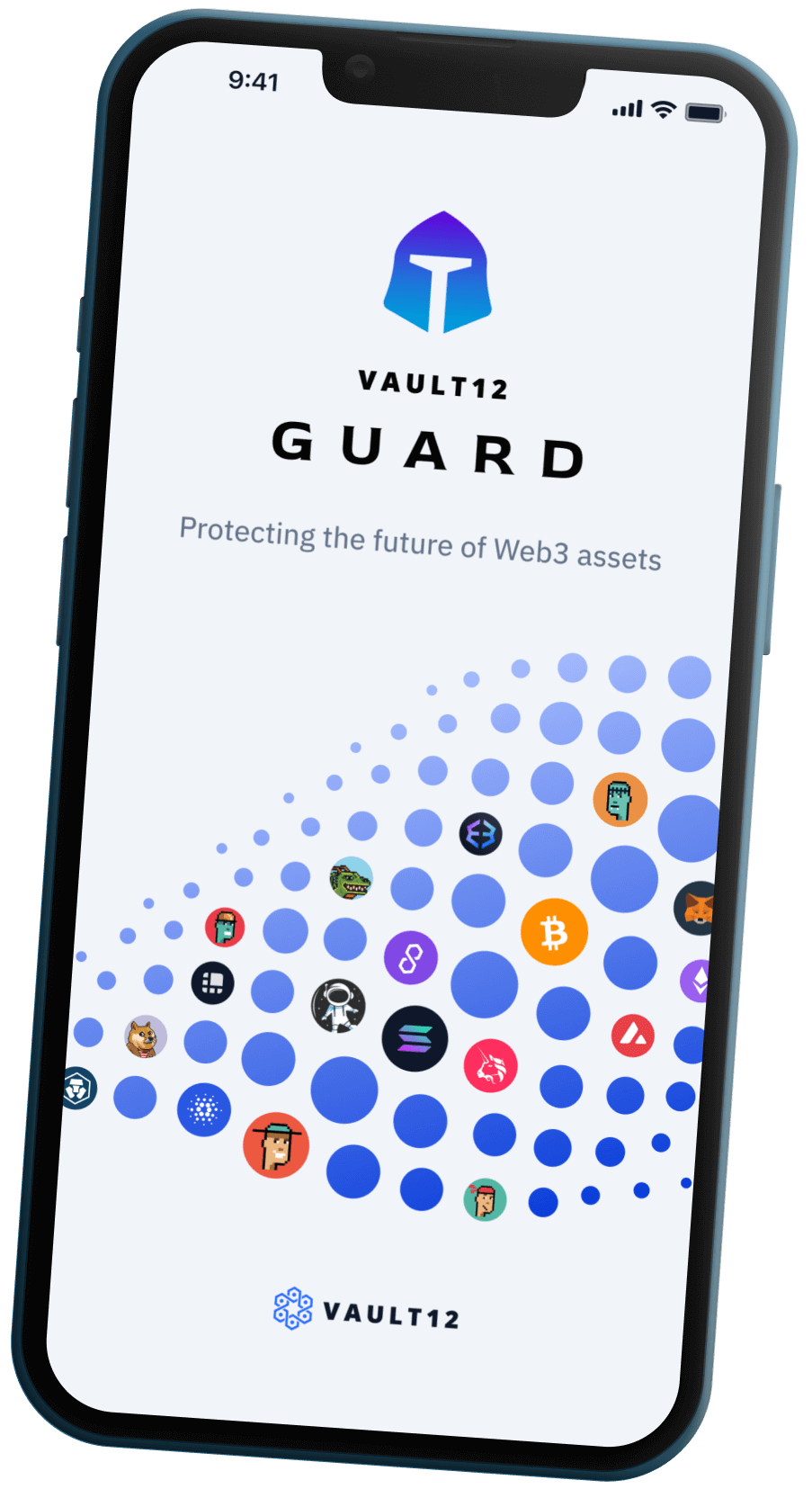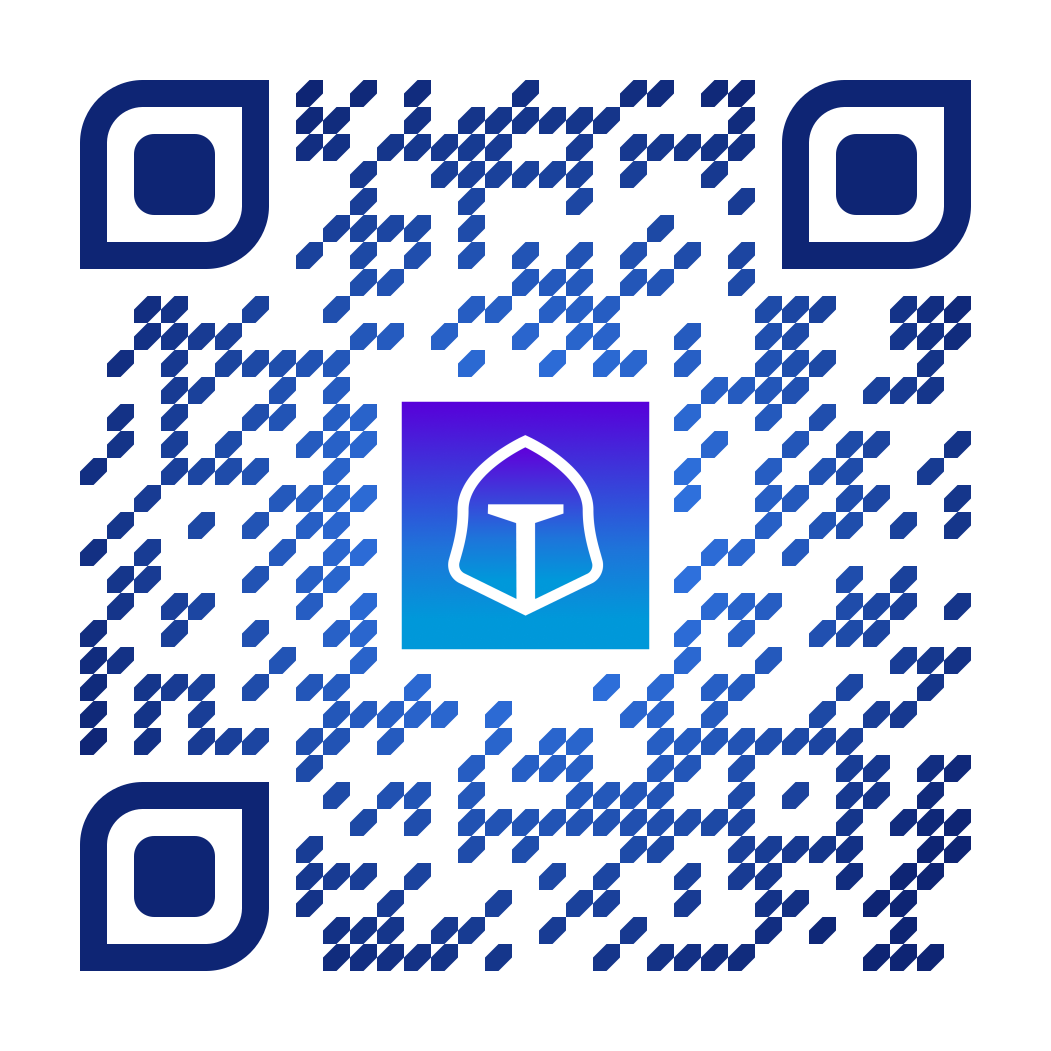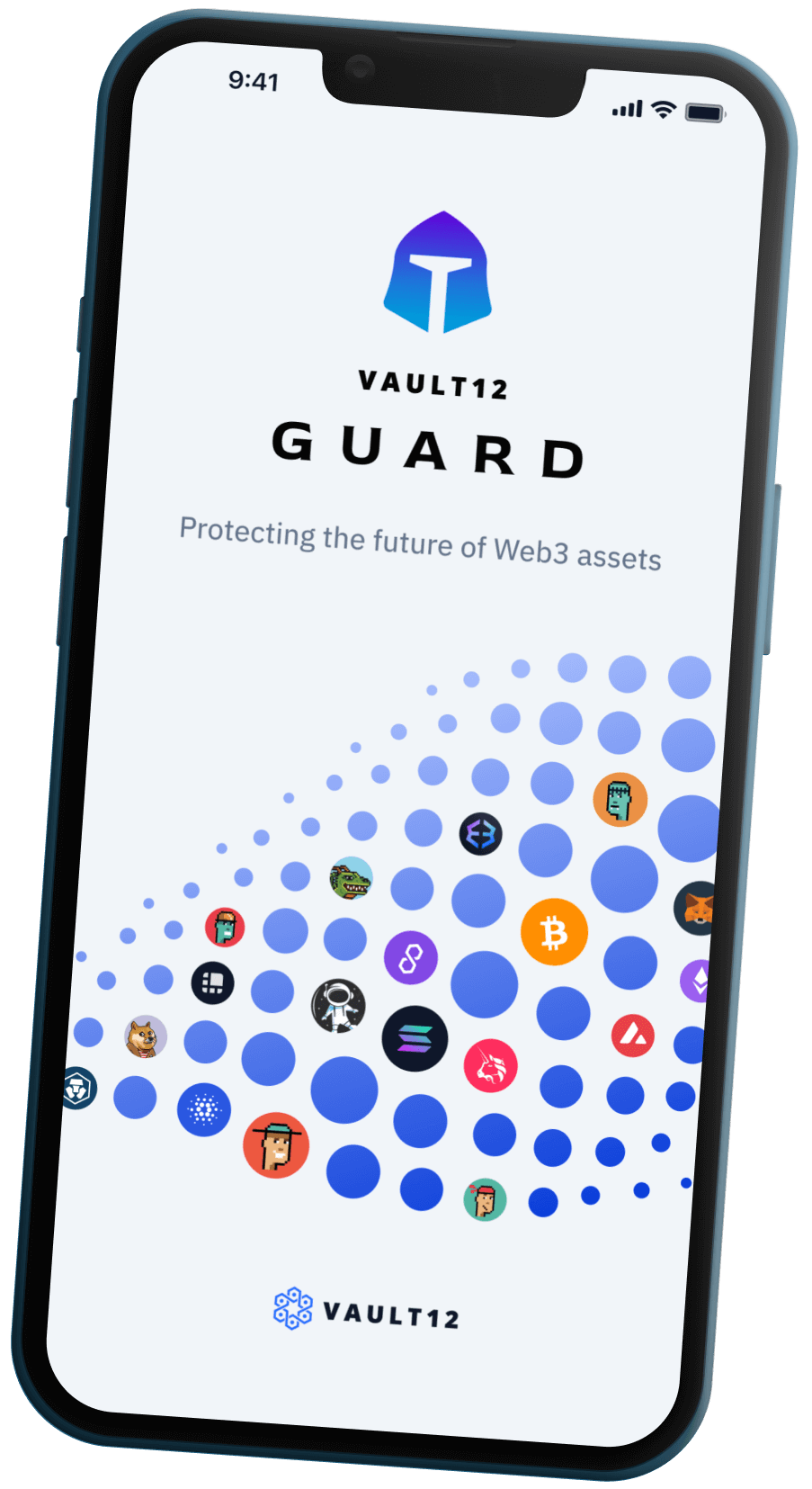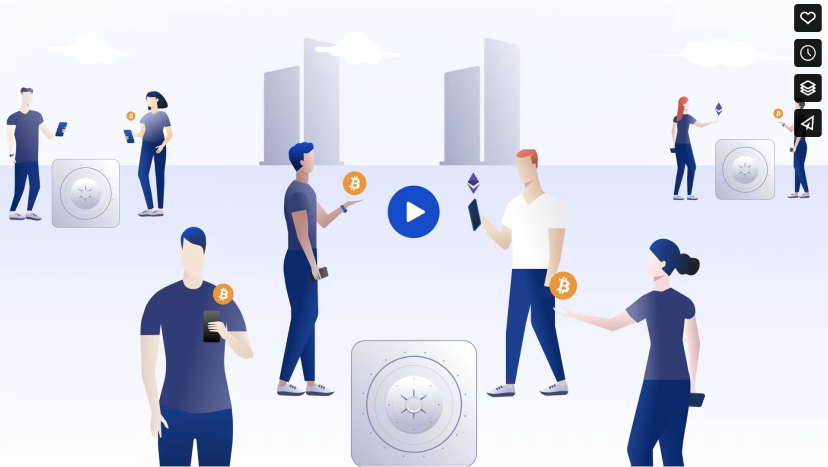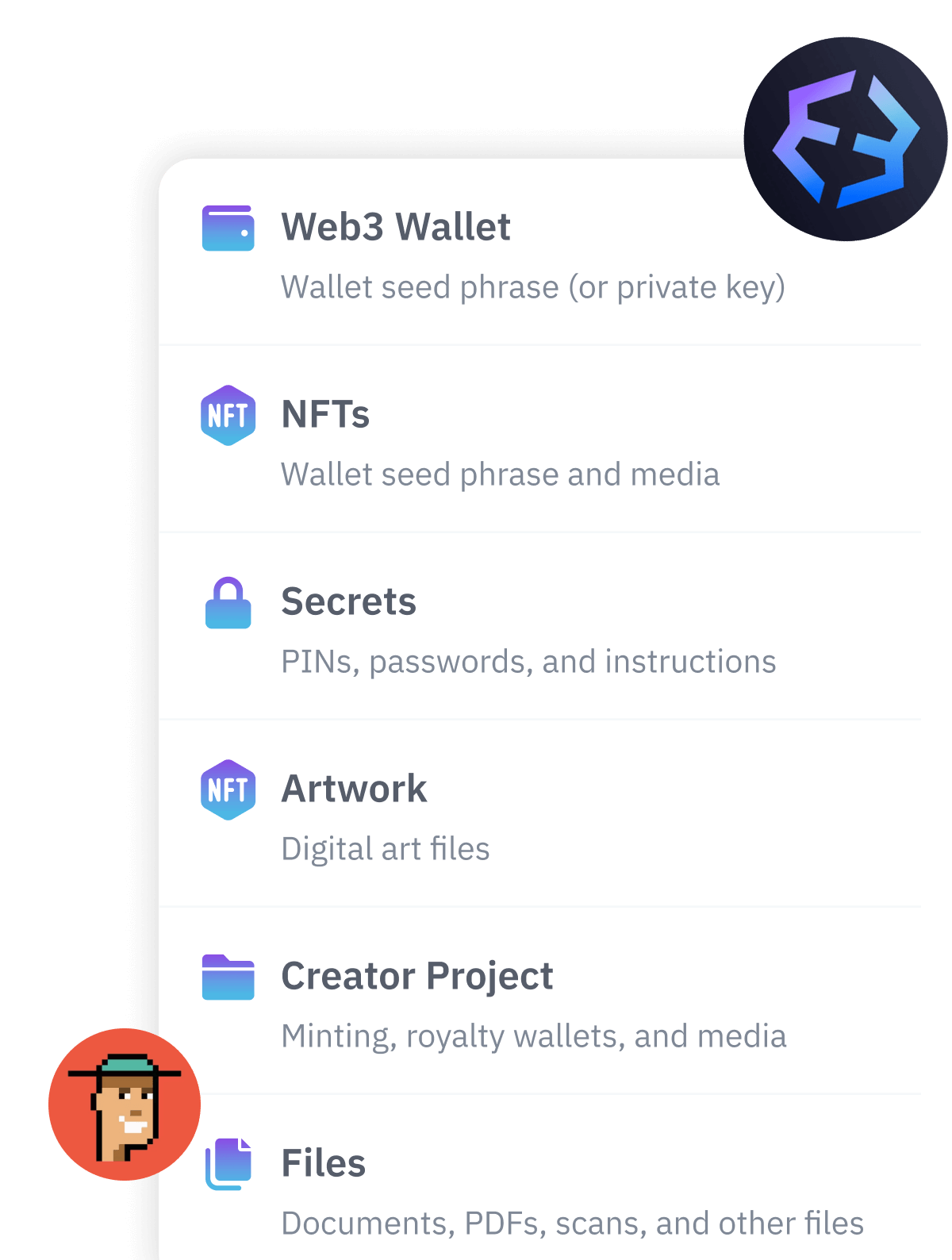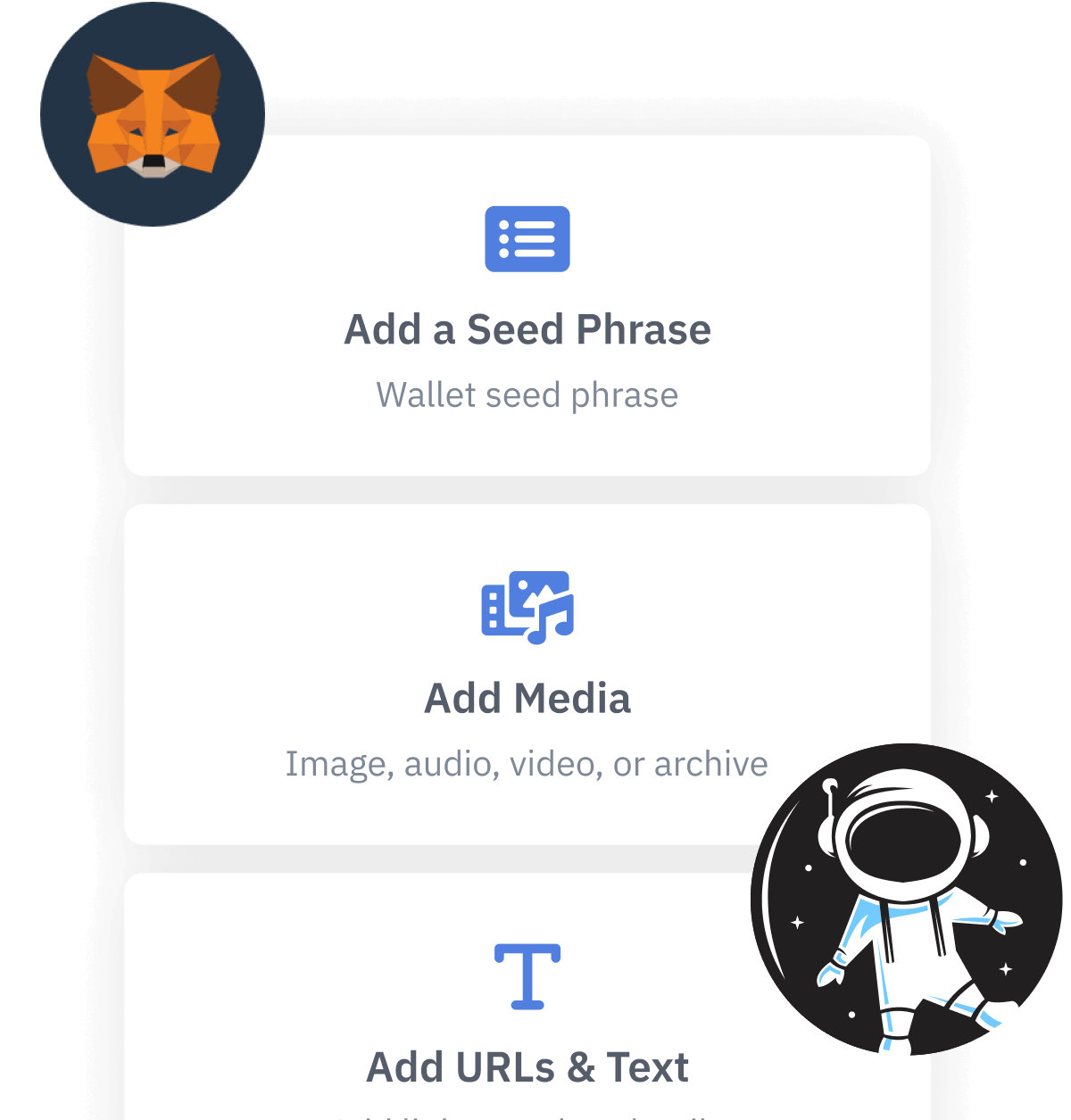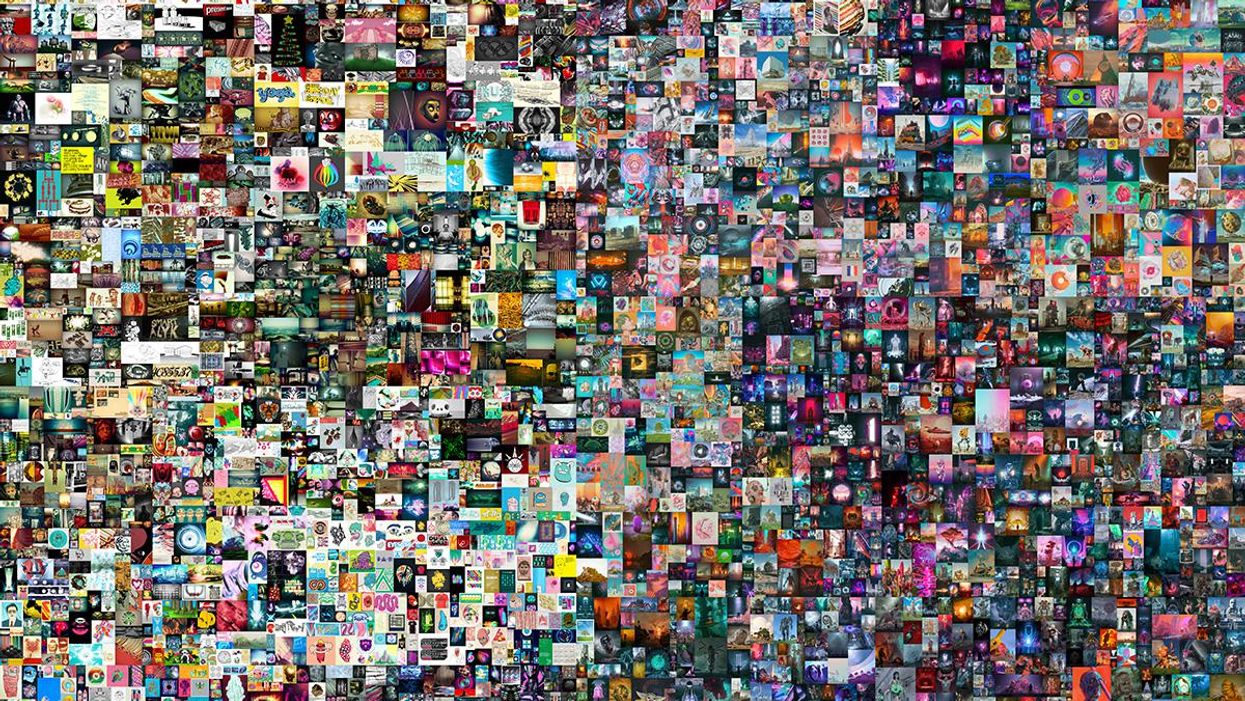
Contents
- What is an NFT?
- How are NFTs different from Cryptocurrency?
- How do I create an NFT?
- How do I buy an NFT?
- How do I secure, protect, and back up my NFTs?
- How to back up from an NFT Platform
- Backing up your Crypto Wallet
- How can NFT Owners Use a Digital Vault to back up NFTs?
- How can you back up your NFT seed phrase in Vault12?
- Creators: Use a Digital Vault to back up NFTs and original artwork
- How to unlock and access assets in the Vault?
How to Self-Custody, Back Up, and Inherit NFTs with Vault12
NFTs enable creators to revolutionize art, but they also support additional use cases, including digitization of many types of unique physical and digital goods (such as concert tickets and identity documents). Learn how you can protect these valuable assets with Vault12.
TL;DR
An NFT ("Niftie") is a blockchain token that is associated with a specific physical or digital asset that has a unique form and value. In contrast, cryptocurrencies such as BTC, ETH, or other altcoins are interchangeable with others of the same type (for example, 1 bitcoin (BTC) = any other BTC).
NFTs can be linked to unique physical assets, e.g., a diamond, a piece of physical art, a digital asset like an online concert ticket, or digital art.
NFTs can be tracked on a blockchain as they are transferred or sold to other people. As an added twist, NFTs can even be programmed so that when they are sold on the secondary market, a portion of the proceeds are automatically sent to the creator, thus creating a whole new motivational value chain for the creator economy.
NFT functionality is still in its infancy, but has the potential to fundamentally change how all types of assets are traded.
You should protect the NFTs you own by using Vault12 to securely back up the wallet that holds the keys to your NFTs. It is especially important for creators, who may have authored a myriad of NFTs, to protect the keys to their NFT wallets, since all proof of ownership revolves around protecting those keys.
What is an NFT?
NFTs, or Non-Fungible Tokens (also known as "Nifties"), are digital assets tracked on a blockchain like any other digital token. The term "non-fungible" means that each token is unique. An NFT and its trading history can be tracked on the blockchain. Unlike Bitcoin, where each BTC is valued the same as any other BTC, NFTs can have different values depending on their attributes, and depending on their unique market demand.
NFTs come in all shapes and sizes, but all of them have two key properties:
- They are linked to actual assets - either physical or digital. Effectively, NFTs express the immutable right of possession. This right is cryptographically fixed in a blockchain as an advanced digital version of a "certificate of ownership."
- They are tracked on the blockchain so that their ownership history can always be verified. This means that not only digital items can be tracked, but physical items that have been tokenized and represented as an NFT can be tracked as well.
This opens a wide range of use cases for NFTs:
Art: Both digital and physical art can be tokenized, traded, and tracked via a blockchain. In a famous example from March 2021, a JPG image produced by digital artist "Beeple" fetched $69 million (lol) in an auction run by famous auction house Christie's. Other high-profile artists, musicians, and creators are creating new art, as well as tokenizing their historical catalogs.
Plane Tickets: Yes, plane tickets (in fact, tickets of all kinds) can be issued, tracked, transferred, and even bought and sold, optionally with a percentage of the ticket price going back to the original issuers.
Baseball Cards: Cards and other collectibles, including limited edition items, can be registered, traded and collected.
Real-world physical assets: Real-world valuable assets like diamonds or real estate can also be tokenized, and then traded! As long as there is clear provenance (a known source, or history of ownership) for the physical items, they can easily be traded on a global market, once they are registered as NFTs.
As for the future of NFTs, there are some incredible possibilities for how Smart Contracts will increase the utility of NFTs even more by supplementing them with real-world, dynamic data. Just consider the possibilities for NFTs beyond their usual function (serving as a record of the chain of custody and ownership): GPS location data can show the physical location of an NFT-tokenized object; real or virtual sports outcomes can offer additional token "rewards" to NFT owners; economic data can be used to automatically modify interest rates used for NFT-tokenized mortgage agreements. A dynamic NFT becomes a trackable asset that can be used for various contractual relationships besides just collectible trading.
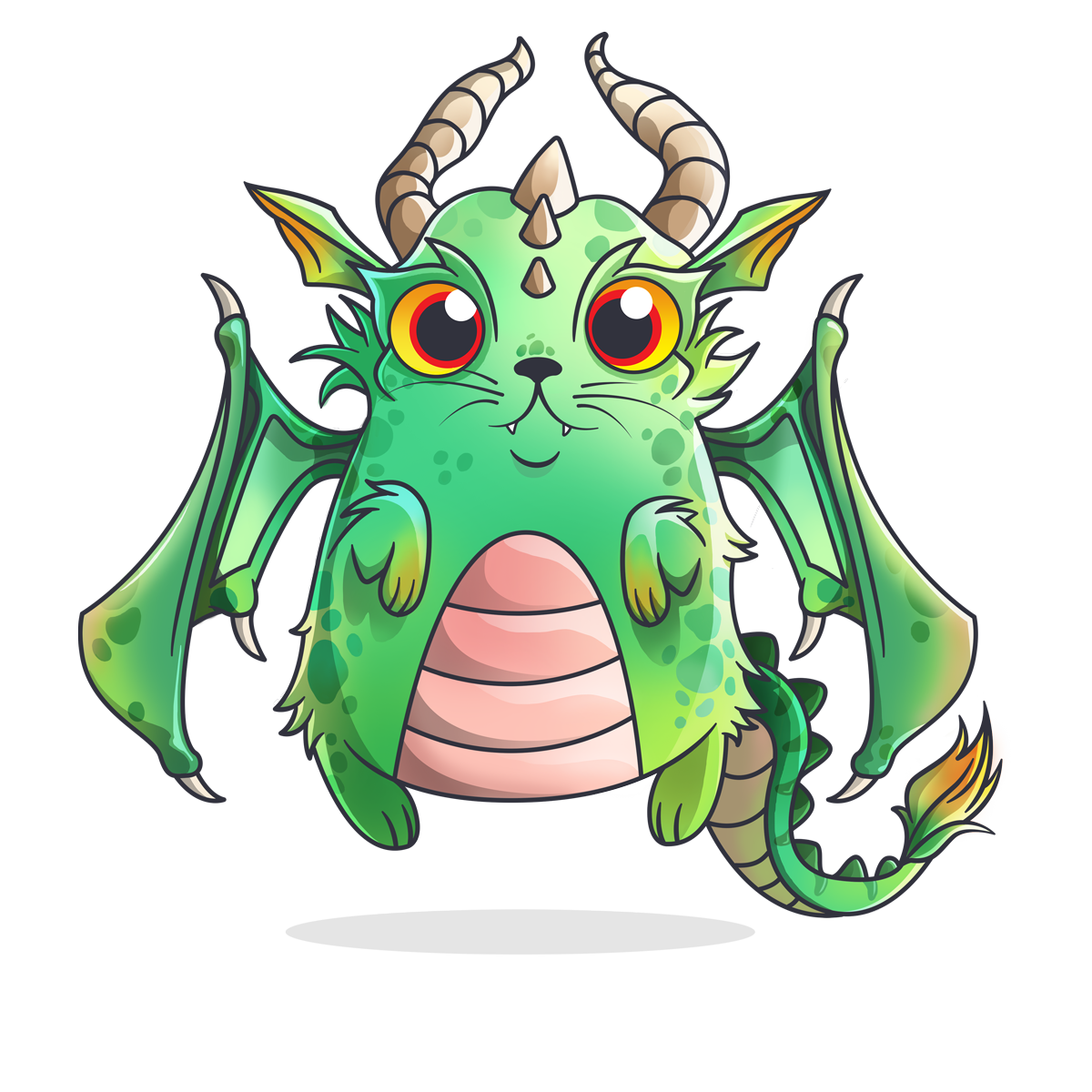


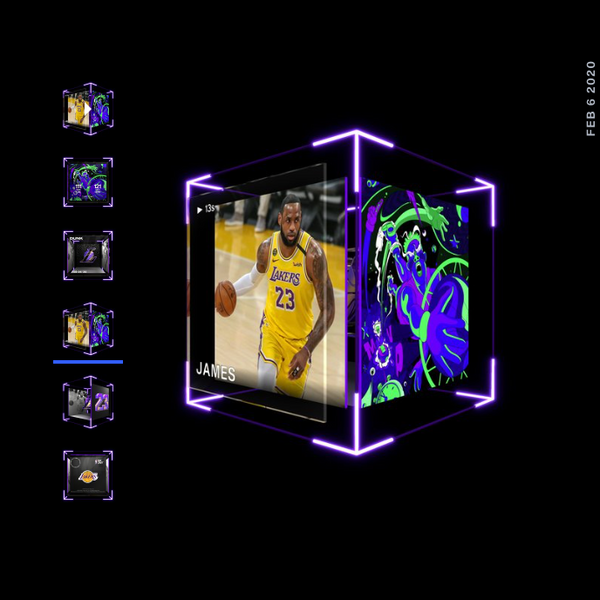
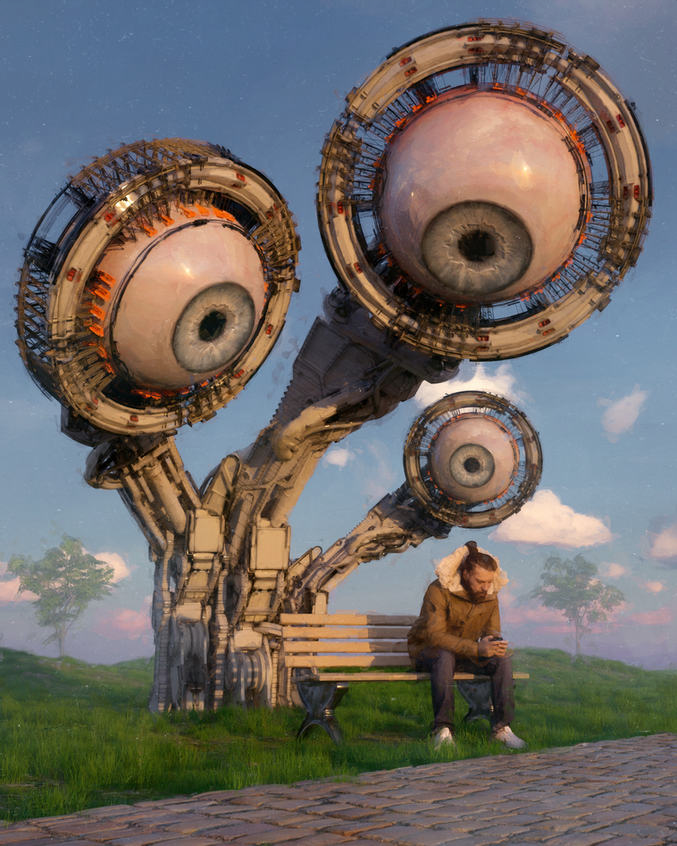

How are NFTs different from Cryptocurrency?
Most NFTs live on the Ethereum blockchain, although some other blockchains also offer NFT support. Unlike cryptocurrency coins like Ether, which are interchangeable with other coins of the same type (fungible), NFTs are unique (just like snowflakes)! So what gets tracked on the blockchain for any given NFT captures its unique properties, as well as its trading history.
How do I create an NFT?
To create an NFT, first choose a blockchain network. Ethereum has the widest range of NFTs today, but some other blockchains that support NFTs include Binance Smart Chain, Flow by Dapper Labs, Tron, Polkadot, Tezos, Cosmos, and WAX, to name a few. Your choice of NFT blockchain network will determine which exchanges and crypto wallets will interoperate with your NFT.
If you choose to use Ethereum for your NFT, you will need a crypto wallet that supports the associated ERC-721 standard. Examples of these wallets are MetaMask, Trust Wallet, Coinbase Wallet, or Rainbow. In addition, you will need some funds in Ether (ETH). All Ethereum transactions will cost a transaction processing fee (also called a "gas" fee).
The NFT trading platforms that enable you to create NFTs include OpenSea, Rarible, and Mintable. To use these NFT platforms, connect your crypto wallet to the platform, click the "Create" button, upload your digital art or other NFT format, and accept the contract terms and details. Once your NFT is signed with your wallet, your NFT is ready to go and can be listed on the blockchain.
How do I buy an NFT?
There are lots of sources to buy NFTs, and there are more coming online every day. The most popular platforms include:
Here's a livestream of the first-ever authenticated Banksy art burning:
How do I secure, protect, and back up my NFTs?
NFTs are registered on the blockchain and linked to your wallet address, so backing up your NFTs follows the same process as backing up a wallet's seed phrase.
If you own the digital art source file itself (regardless of its format), you can also back this up in a Digital Vault. This ensures that your copy of the art is also protected from being accidentally deleted or lost. This is especially important for NFT art that may happen to pass through many hands (e.g., auction houses), and is also important for insurance purposes.
Read on for step-by-step instructions for how to protect your NFTs and original artwork using Vault12.
How to back up from an NFT Platform
Once a creator or developer has created an asset, it needs to be "minted" on an NFT platform. Minting is the process of registering the asset on the blockchain and activating the smart contract that governs the NFT (e.g., these terms can include what percentage of future sales are credited back to the creator). Once minted, the NFT can be made available for purchase. Buyers will purchase from the NFT platform directly, using their crypto wallet.
NFT Platforms support wallets in different ways. Some wallets can display NFT records, others cannot (we're still in early days of this technology).
In the following example, we will use Opensea.io (a leading NFT platform), and the Metamask mobile wallet:
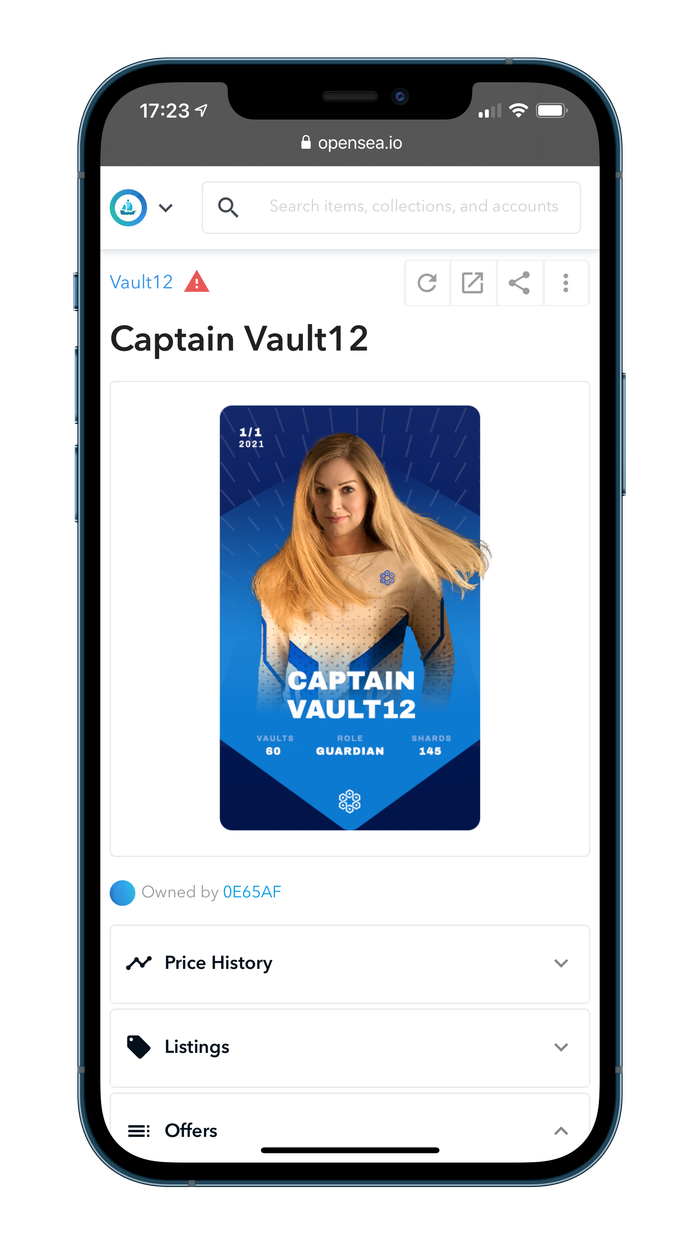
Opensea.io
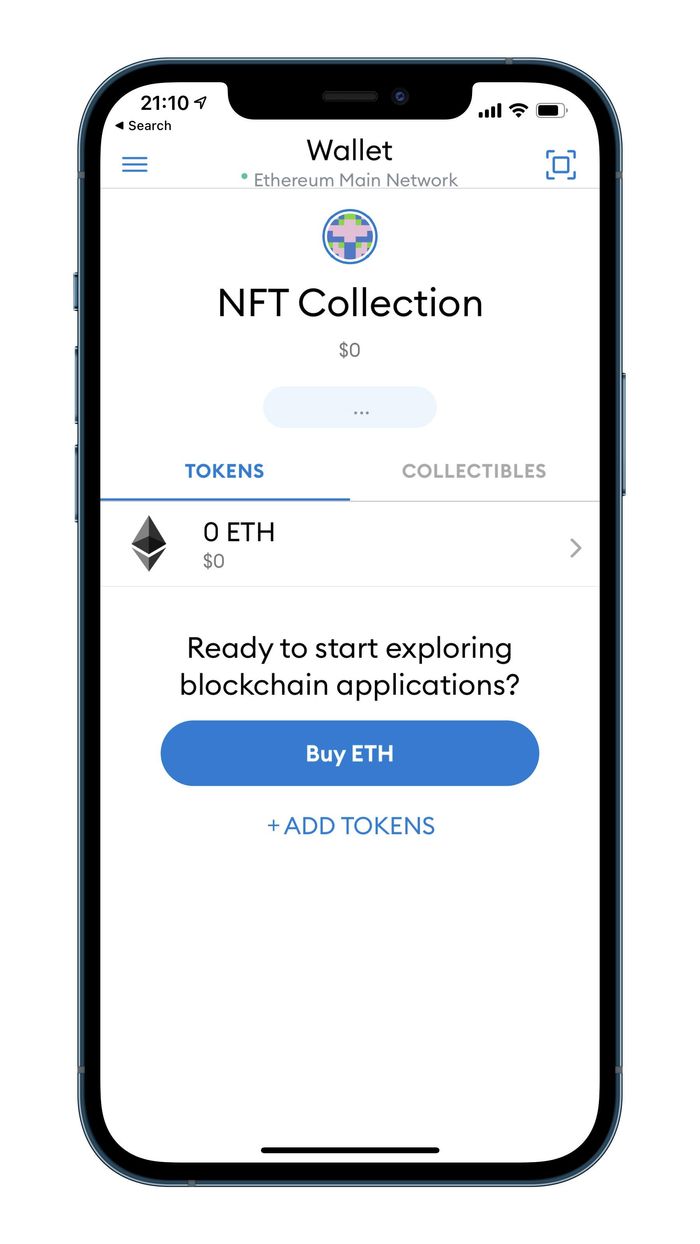
Metamask mobile wallet
With NFTs (as with standard cryptocurrency), the wallet seed phrase becomes the most important piece of information to back up and secure.
Here's how to reveal the seed phrase in our Metamask Wallet so that it can be backed up:

1. Settings

2. Security & Privacy

3. Reveal seed phrase

4. Seed phrase displayed
Backing up your Crypto Wallet
Once you have access to your seed phrase, you can back it up with a Digital Vault from Vault12.
In the following sections, we will demonstrate how owners of NFTs, as well as creators, can utilize a Digital Vault as the mechanism to store seed phrases, as well as secure the original asset.
How can NFT Owners Use a Digital Vault to back up NFTs?
A Digital Vault has the advantage of being focused on a singular purpose: securely storing digital assets for long term use. While there are many types of "digital vaults" available for cryptocurrency storage, for NFTs it is better to use something that is independent of any one blockchain and can store any type of digital asset.
Here we will use Vault12 to demonstrate how an NFT can be backed up, and how digital assets can also be stored in a Vault:
Step 2: Add a new asset to your Vault: in this case an NFT. First, switch to the Vault screen by tapping on the vault icon on the bottom navigation pane. Tap Add an Asset, and choose NFTs.


How can you back up your NFT seed phrase in Vault12?
Start by choosing "Add a Seed Phrase" to add your NFT wallet's seed phrase. For convenience, the name of the software wallet type that you use to control the NFT will be suggested, but you can use any name.
Entering the seed phrase could be done by choosing either "Enter each word," or "Free format text." If you want to refresh your memory about the details of seed phrases, you can do that here.


As soon as you finish entering the seed phrase words, choose the name for the asset (or use the one proposed by the application), and choose between storing whether you want to hold the local copy, or only store a backup with your Vault Guardians.

Finally, you will be returned to the Digital Vault screen that will display your added asset and indicate the status of its distribution to your Guardians.

Creators: Use a Digital Vault to back up NFTs and original artwork
For creators, in addition to backing up wallets that contain NFT collections, there's also the option to back up the original artwork itself - this could be the form of an image, video or some other file format.
To add the artwork to your Vault, simply tap the "Add an Asset" option on your Vault screen, then choose "Add Media."

In this simple way, you can add files, images, or other media from files on your device or from your Photo Library to back up the source files of your highly valuable media.


The final step is to give a name to your selected asset (you can associate it with the seed phrase name, to ease tracking of inventory), and choose whether you want to keep a local copy.

How to unlock and access assets in the Vault?
To gain access to your asset or artwork, select the asset in your Vault, and tap the "Unlock Asset" option.
To learn more about accessing the assets that are locked in your Vault, please read How to access your Seed Phrase or asset stored in Vault12.
The NFT market is new and constantly evolving, and there have already been hacking attempts on several platforms where owners and creators ended up having their accounts drained. Please make sure that you are using well-known and highly trusted wallets to associate with your collection of NFTs. Follow the guidelines laid out in this article to make sure you are able to robustly secure and back up your NFTs - whether you bought them or created them yourself.
Next Up From Vault 12
Discover more
How to Self-Custody, Back Up, and Inherit NFTs with Vault12
NFTs enable creators to revolutionize art, but they also support additional use cases, including digitization of many types of unique physical and digital goods (such as concert tickets and identity documents). Learn how you can protect these valuable assets with Vault12.

Max Skibinsky
Max Skibinsky is a serial entrepreneur, angel investor, and startup mentor. Most recently, Max was an investment partner with Andreessen Horowitz, where he focused on enterprise security and bitcoin and deals with Tanium, TradeBlock, and Digital Ocean. In addition to co-founding Vault12, Max leads the R&D team. Before that Max was the founder and CEO of Hive7, a social entertainment company that became part of The Walt Disney Company. In 2003, Max joined the newly formed Voltage Security, an encryption startup incubated at Stanford University, where he architected and designed an Identity-Based Encryption messaging system that was showcased at DEMO '04. Voltage was acquired by Hewlett Packard in 2015. Max has also advised and invested in many startups graduating from Y Combinator including Eligible, Transcriptic, and ZenPayroll. Max graduated with a masters' degree in theoretical and mathematical physics from Moscow State University.

Wasim Ahmad
Wasim is a serial entrepreneur and an advisor in the fields of AI, blockchain, cryptocurrency, and encryption solutions. At Vault12, the pioneer of crypto inheritance, he led the private and public fundraising efforts and focuses today on expanding the Vault12 ecosystem. His crypto experience began with AlphaPoint, where he worked with the founding team to launch the world's first crypto trading exchanges. Previously he was a founding member of Voltage Security, a spinout from Stanford University, that launched Identity-Based Encryption (IBE), a breakthrough in Public Key Cryptography, and pioneered the use of sophisticated data encryption to protect sensitive data across the world's payment systems. Wasim serves on the board of non-profit, StartOut, and is a Seedcamp and WeWork Labs global mentor.
Wasim graduated with a Bachelor of Science in Physics and French from the University of Sussex.

Brandon Forant
Brandon is a creative director and product designer with experience consulting for Fortune 500 companies and startups. He has experience with cybersecurity, enterprise trading, and personal banking.
Brandon was the co-founder of Alchemy50, a Brooklyn-based product design firm. A50 was acquired in 2017 and their clients included United Healthcare, Dataminr, and Betterment. He has also designed security products for Comcast, trading platforms at Reuters, and advised on autonomous banking initiatives at Citi. Brandon graduated with a Bachelor of Science Degree in graphics design communication from Philadelphia University.

Vault12
Vault12 is the pioneer in crypto inheritance and backup. The company was founded in 2015 to provide a way to enable everyday crypto customers to add a legacy contact to their cry[to wallets. The Vault12 Guard solution is blockchain-independent, runs on any mobile device with biometric security, and is available in Apple and Google app stores.
You will lose your Bitcoin and other crypto when you die...
...unless you set up Crypto Inheritance Management today.
It's simple — if you don't worry about crypto inheritance, nobody else will — not your software or hardware wallet vendors, not your exchanges, and not your wealth managers. So it's up to you to think about how to protect the generational wealth you have created, and reduce the risks around passing that crypto wealth on to your family and heirs. What are the challenges with crypto inheritance?
- Crypto Wallets are difficult to use and do not offer crypto inheritance management. In fact, most of them tell you to write down your seed phrase on a piece of paper, which is practically useless.
- Some people back up their wallet seed phrases or private keys on paper, local devices like hardware wallets or USBs, or in the cloud. All of these options have severe drawbacks that range from hacking to accidental loss to disrupted cloud services.
- Software wallets operate onspecific blockchains, yet your crypto assets span multiple blockchains. For inheritance to work, you must be able to manage inheritance across every blockchain — now and forever.
Crypto Inheritance Management: Secure, Self-Custody Crypto Inheritance and Backup
Vault12 is the pioneer in Crypto Inheritance Management, offering a simple yet powerful way to designate a legacy contact and pass on your crypto assets—like Bitcoin (BTC), Ethereum (ETH) and Solana (SOL) —to future generations. Built for everyday users yet robust enough for the most seasoned crypto enthusiasts, Vault12 Guard ensures your wallet seed phrases and private keys are preserved in a fully self-sovereign manner, across all Blockchains.
At the heart of Vault12 Guard is quantum-resistant cryptography and a decentralized, peer-to-peer network of trusted Guardians. Your critical information is never stored in the cloud, on Vault12 servers, or even on local devices—dramatically reducing the risk of a single point of failure. By fusing a powerful software layer with the Secure Element of iOS devices (Secure Enclave) and Google devices (Strongbox), Vault12 Guard locks down your private keys against present and future threats.
Our innovative approach harnesses social recovery, enabling you to appoint one or more trusted individuals or mobile devices as Guardians. These Guardians collectively safeguard your protected seed phrases in a decentralized digital Vault—so there’s no need for constant lawyer updates or bulky paperwork. Should the unexpected happen, your chosen legacy contact can seamlessly inherit your crypto assets without compromising your privacy or security.
Preserve your digital wealth for generations to come with Vault12 Guard—the simplest, most secure way to manage crypto inheritance and backup.
Take the first step and back up your crypto wallets.
Designed to be used alongside traditional hardware and software crypto wallets, Vault12 Guard helps cryptocurrency owners back up their wallet seed phrases and private keys (assets) without storing anything in the cloud, or in any single location. This increases protection and decreases the risk of loss.
The first step in crypto Inheritance Management is making sure you have an up-to-date backup.
The Vault12 Guard app enables secure decentralized backups, and provides inheritance for all your seed phrases and private keys across any blockchain, including Bitcoin, Ethereum, and others, and for any crypto wallet.
Note: For anyone unfamiliar with cryptocurrencies, Vault12 refers to wallet seed phrases and private keys as assets, crypto assets, and digital assets. The Vault12 Guard app includes a software wallet that works alongside your Digital Vault. The primary purpose of this is to guard your Bitcoin (BTC) and Ethereum (ETH) wallet seed phrases, private keys, and other essential data, now and for future generations.

